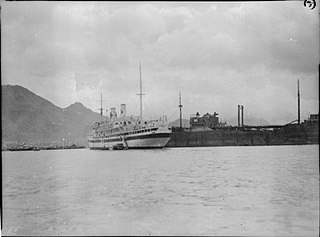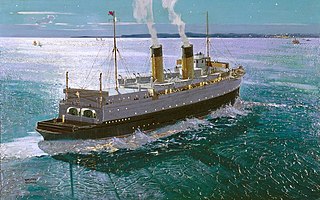Storaa was a 1,980 GRT cargo ship which was built in 1918 by the Greenock & Grangemouth Dockyard Company as Wellpark for British owners. In 1927, she was sold to Belgium and was renamed Navex. A further sale in 1937 saw her renamed Prina. In 1938, she was sold to the Netherlands and was renamed Willy. In 1939, she was sold to Denmark and was renamed Storaa.

RFA Maine was a 7,432 GRT hospital ship which was built in 1924 as the ocean liner Leonardo da Vinci by SA Ansaldo, La Spezia, Italy for the Società di Navigazione Transatlantica Italiana. In 1941, she was captured by the British at Kismayu, Italian Somaliland. Declared a prize of war, she was passed to the Ministry of War Transport (MoWT) and renamed Empire Clyde, serving as a hospital ship for the British Army during the Second World War. In 1948, ownership was passed to the Admiralty and she entered service with the Royal Fleet Auxiliary as RFA Maine. She served during the Korean War and was scrapped in 1954.
Jamnagar was a 576 GRT coaster which was built in 1924 for Maharaja Jam Sahib of Nawanagar. In 1941 she entered service with the Royal Indian Navy. In 1944, she was sold into merchant service before being requisitioned by the Ministry of War Transport (MoWT) and renamed Empire Bulbul. In 1947, she was sold into merchant service and renamed Hellenic Bulbul. The name Hellenic Bee had been allocated but she ran aground and sank before the proposed name change could be implemented.
Brittany was a 631 GRT passenger ferry built in 1910 for the London, Brighton and South Coast Railway. In 1912 she was sold to the London and South Western Railway, passing to the Southern Railway on 1 January 1923. She was renamed Aldershot in 1933. In 1937 she was sold to an Italian owner and renamed Hercules. On 24 November 1941, she was torpedoed and sunk by HMS Triumph.
Stettin was a 2,646 GRT cargo ship which was built in 1923 for the Stettiner Dampfer Compagnie. In 1930 she was sold to Norddeutscher Lloyd and renamed Akka. She was requisitioned by the Kriegsmarine in 1940. Akka was seized as a war prize in 1945, passing to the Ministry of War Transport (MoWT) and being renamed Empire Calder.
Empire Caribou was a 4,861 GRT cargo ship which was built in 1919 for the United States Shipping Board (USSB) as Waterbury. She was sold in 1920 to the American Star Line and renamed Northern Star. In 1923, she was sold to American Sugar Transporters Inc and renamed Defacto. In 1941 she was passed to the Ministry of War Transport (MoWT) and renamed Empire Caribou. On 10 May 1941, she was torpedoed and sunk by U-556.
SS Empire Chamois was a 5,864 GRT cargo ship which was built in 1918 by Ames Shipbuilding and Drydock Co, Seattle. She was ordered by the Compagnie Générale Transatlantique but was requisitioned by the United States Navy and commissioned as USS West Mount with the pennant number ID-3202 in 1918. She was decommissioned in May 1919 and passed to the United States Shipping Board (USSB) as SS Westmount. In 1927 she was sold to the Dimon Steamship Corporation and renamed SS Pacific Redwood. She returned to the USSB in 1932 and passed to the United States Maritime Commission (USMC) in 1937. In 1940, she was passed to the Ministry of Shipping, passing to the Ministry of War Transport in 1941 and being renamed SS Empire Chamois. She was sold to Astral Shipping Co Ltd in 1946 and renamed SS Granview. In 1949 she was sold to the Compagnia Maritime del Este, Panama and renamed SS Chamois, serving until 1958 when she was scrapped. She was the last Ames-built ship afloat.
Almeria Lykes was a 7,773 GRT Type C3 cargo ship that was built in 1940 by Federal Shipbuilding and Drydock Company, Kearny, New Jersey for the Lykes Brother Steamship Co. She was transferred to the Ministry of War Transport (MoWT) and renamed Empire Condor. In 1942, she was transferred to the United States Maritime Commission (USMC) and renamed Almeria Lykes. She was torpedoed by Axis motor torpedo boats on 13 August 1942 and later scuttled.
Elbe was a 1,197 GRT cargo ship that was built in 1921 by Nobiskrug Werft, Rendsburg for German owners. She was seized by the Allies at Copenhagen, Denmark in May 1945, passed to the Ministry of War Transport (MoWT) and renamed Empire Confederation. In 1946, she was transferred to the Soviet Union and renamed José Dias. She served until she was scrapped in 1966.
Deneb was a 1,080 GRT cargo ship that was built in 1923 as Rhenania by Nüscke & Co, Stettin for German owners. She was sold in 1924 and renamed Marth Halm In 1927, she was sold to Finnish owners and renamed Bore VII. She ran aground in 1936 and was declared a total loss. In 1937, she was sold to Germany, repaired and renamed Götaälv. In 1938 she was sold and renamed Bernhard Schulte. In 1941, she sank off the Lofoten Islands but was salvaged and repaired.
Ambria was a cargo ship that was built in 1922 by Deutsche Werft, Finkenwerder for German owners. She was sold in 1934 and renamed Gumbinnen. She was sunk by a British destroyer in 1941, raised and repaired. Gumbinnen was seized by the Allies in Flensburg, in May 1945, passed to the Ministry of War Transport (MoWT) and renamed Empire Conleith. In 1946, she was allocated to the Norwegian Government and renamed Dragnes. She was sold into Norwegian merchant service and renamed Mimona. In 1959, she was sold and renamed Malay. She served until 1961 when she was scrapped.
Charlotte Cords was a cargo ship that was built in 1923 by Neptun AG, Rostock for German owners. She was seized by the Allies in Travemünde in May 1945, passed to the Ministry of War Transport (MoWT) and renamed Empire Connah. In 1946, she was allocated to the Soviet Government and renamed Nikolai Bauman. The ship was scuttled while carrying a cargo of nuclear waste in 1964.
Ganter was a 1,771 GRT cargo ship that was built in 1927 by G Seebeck AG, Bremerhaven, Germany for German owners. She was requisitioned by the Kriegsmarine during the Second World War and operated as Transporter RO 29, she was seized by the Allies in May 1945. She was passed to the Ministry of War Transport (MoWT) and was renamed Empire Consistance, being sold into merchant service in 1948. In 1950, she was sold to the Dutch government and renamed Jan Willem and then sold and renamed Maria in 1951. She was sold to Finnish owners later that year and being renamed Dagny. She served until she was scrapped in 1967.

Barlind was a 1,453 GRT cargo ship that was built in 1938 as Süderau by Deutsche Schiff- und Maschinenbau AG, Bremen, Germany for German owners. She was seized by the Allies in May 1945, passed to the Ministry of War Transport (MoWT) and was renamed Empire Content. In 1946, she was allocated to Norway and renamed Svartnes. She was sold into merchant service in 1947 and renamed Barlind. In 1971, she was sold to Greece and renamed Ikaria. She served until 1972 when she was scrapped.
Alk was a 1,175 GRT cargo ship that was built in 1924 by Neptun AG, Rostock, Germany for German owners. She was seized by the Allies in May 1945, passed to the Ministry of War Transport (MoWT) and was renamed Empire Contest. In 1946, she was allocated to the Soviet Union and renamed Vereshyagin (Верещагин). She served until about 1960, being deleted from Lloyd's Register in that year.
MV Wotan was a 5,703 GRT tanker that was built in 1913 by Reiherstieg Schiffswerft & Maschinenfabrik, Hamburg, Germany. Requisitioned by the Imperial German Navy in 1914, she served until 1915 as SMS A and was then returned to her owners. Ceded to the United States in 1919, she was operated until 1920 then laid up following an engine failure.
Kolno was a 2,487 GRT cargo ship that was built in 1936 as Nordcoke by Lübecker Flenderwerke AG, Lübeck, Germany. In 1940, she was requisitioned by the Kriegsmarine and was renamed Nordlicht. In 1945, she was seized by the Allies at Hamburg, passed to the Ministry of War Transport (MoWT) and was renamed Empire Conwear. In 1946, she was passed to the Soviet Union and renamed Armavir. In 1947, she was sold to Poland and renamed Kolno. She served until 1971 when she ran aground off Falsterbo, Sweden, following which she served as a hulk until scrapped in 1983.
Empire Conyngham was a 1,408 GRT cargo ship that was built as Marie in 1899 by Neptun AG, Rostock, Germany for German owners. A sale in 1923 saw her renamed Norburg. She was sold to Latvia in 1925 and renamed Gauja, serving until 1941 when she was captured by the Kriegsmarine in the Baltic Sea. In 1945, she was seized by the Allies, passed to the Ministry of War Transport (MoWT) and was renamed Empire Conyngham. In 1946, she was scuttled with a cargo of obsolete bombs.

Twickenham Ferry was a train ferry built in 1934 for the Southern Railway. She served during the Second World War as a minesweeper and returned to merchant service post-war, serving until 1974 when she was scrapped.
Empire Florizel was a 7,056 GRT cargo ship that was built in 1943 by Lithgows, Greenock, Renfrewshire, United Kingdom for the Ministry of War Transport (MoWT). She had a short career, being bombed and sunk during the Allied invasion of Sicily exactly three months after her launch.


